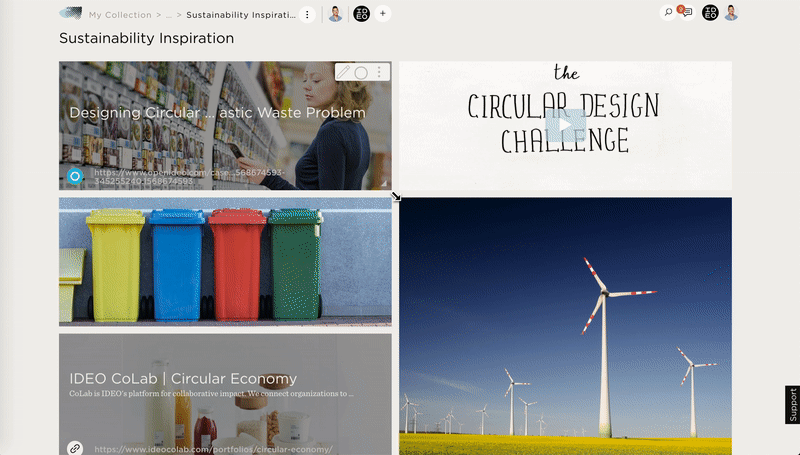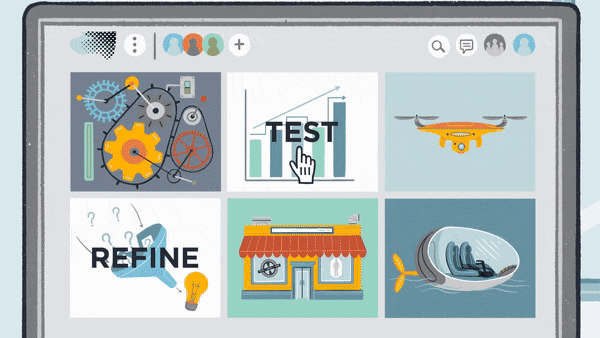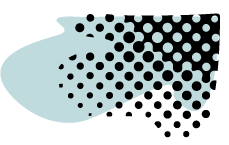What Most Organizations Get Wrong with Innovation Challenges and How You Can Avoid the Same…


What Most Organizations Get Wrong with Innovation Challenges and How You Can Avoid the Same Mistakes
By David Aycan and Sophie Chow
When leaders want to grow or change their organizations, they often use surveys, workshops, or corporate challenges to solicit ideas from their employees (and sometimes even customers). This kind of activation can bring a cross-functional organization together under a united mission, breathe life into processes that just don’t work as well as they could, and spark the community to imagine the organization’s best possible future. This energy is kinetic — and in the right applications, game-changing.
So why do so many organizations fail to meet the enthusiasm they inspire with anything beyond a lackluster follow-through? It’s with that question that we started a deep investigation of what is and isn’t working about an organization’s approaches to inclusive innovation — an investigation that ultimately led to our new challenge and collaboration platform, Shape.

We found that the excitement and support created by these experiences can move mountains — but without a transparent and thoughtful follow-up process, leaders can inadvertently create resentment and distrust by reinforcing ideas about the organization being “too big to care.” The individual participant might see somebody else ‘win’ the challenge, or they might receive an auto-generated ‘Thanks for your idea’ e-mail and nothing else. In that moment, the human connection is ultimately lost, taking along with it the opportunity for meaningful innovation. Can you imagine a more effective way to make someone feel like they don’t matter?
Our research has shown that leaders who can engage their employees and effectively involve them in the process of addressing the most pressing challenges faced by their organization have a lead over their competition.
Teams that know the process and have a clear path to move new ideas forward are 16% more successful than teams who do not. (Source: Creative Difference)
In today’s increasingly impersonal and automated world, the biggest value people bring to an organization is their collective humanity, creativity, and passion for new ideas. So what can you do to activate your most creatively engaged community members? We’ve talked to dozens of leaders to find out what works, what doesn’t — and which practices often have the opposite of their intended effect. These insights have informed our new approach to organizational challenges.
Keeping focus can strengthen results
Strategy and purpose are the pillars of any good organization. Why are some leaders inclined to arbitrarily shift the focus of corporate challenge areas each month when it makes more sense to immerse employees in the most essential priorities of the organization? This can lead them to collectively build deeper insights and fine-tune their efforts towards achieving larger goals. One challenge manager at a leading European airline found that by focusing their innovation challenges on the company’s top strategic issues, they saw a significant increase in participation, collaboration and overall quality of ideas from their employees:
“The challenge topic can make or break a challenge,” she explains. “It’s crucial to find a topic that serves a common purpose and motivates your employees to work on something important together.”
Keeping the focus consistent over time can help people work towards the innovation strategy, purpose, and top priorities of an organization, allowing participants to learn what works and what doesn’t by collaborating together. Employees also want to feel the impact of the time and energy they invest in change work, so it’s important to create healthy feedback cycles even when everyone is heads down. Deadlines and milestones are an effective tool to create urgency. A checkpoint cadence that allows the best ideas to get funding, sponsorship, and support (without shutting down in-progress innovation work) helps everyone stay on track.
One try is never enough

People who aren’t quite fluent in innovation practice often tend to jump from a problem to a solution, skipping over the research portion of the design process. By stoking curiosity around both the problem and the context where a solution must live, you can uncover a more holistic understanding of what’s happening. Inspiration for innovation should ideally come from many sources at the same time: customer feedback, competitive analysis, experimentation, learning from doing, and pulling together strategies that have been successfully applied at other companies. Iterate, rinse and repeat.
Curiously, many challenges are structured around a prolonged one-time sprint towards a solution, rather than supporting and endorsing iteration and learning. For those new to creative problem-solving methods, this experience often feels counterintuitive and provides a warped view of what iteration should look like in practice. This leaves individuals feeling less empowered to experiment or search for new solutions as they apply the principles of innovation to their work.
Jens Uehlecke, Managing Director at Greenhouse Innovation Lab, has flipped his approach, allowing the pace of learning to dictate the design timeline at his organization.
“We abandoned trying to match everyone into cohorts to go through phases because it proved ineffective at getting people to have a solid understanding of the topic,” he said. “Now we let a team’s readiness and comfort with the problem space determine the pace.”
Bring in outside perspectives to shatter the status quo

As we reviewed the processes of dozens of challenge managers, we were shocked to find an acute lack of perspective from customers or external stakeholders as part of the idea selection and critique process. Without a diversity of perspective, the challenge itself easily becomes an echo chamber of existing assumptions held by the organization and/or its larger community. This stops true innovation in its tracks.
Incremental ideas that support the status quo are more likely to win in the corporate environment, and more innovative ideas that challenge existing notions or expectations are more likely to be left unsupported. An innovation manager from a financial institution shared with us that this has certainly been his personal experience.
“We always have to fight internal social voting because people would just vote for their favorite colleague’s ideas!”
Incorporating feedback very early in the challenge process can actually spur enthusiasm and stoke innovation. When you encourage individuals to listen to real, on-the-ground feedback from customers about their experience, it can shape the process of building new ideas. For a challenge manager at Umpqua Bank, bringing in the customer voice to the table when tackling the company’s challenges was an essential step for her team.
“An external perspective is essential to reducing risk when bringing new ideas to market,” she said.
It’s critical to assemble a diverse review panel, and include customer and employee feedback as a central part of the process. Hearing from real people with real insights about the challenges they face can actually inspire a more rigorous, thoughtful approach to creating the solutions they need. Listening is a critical step in finding new solutions.
Build a community around your challenges

Most challenge-based innovation work is framed as a contest: with a narrow suite of ‘winners’ being selected from a stack of solutions, and the rest of the ideas thrown away. Anne-Laure Fayard, Associate Professor of Innovation, Design and Organizational Studies at NYU, shared her frustration with this process, saying,
“I’ve participated in tens of challenges over the last 8 years. I’m passionate about these topics and want a way to work on my ideas and collaborate on other ideas regardless of if they are deemed ‘top ideas’ or not.”
Despite the ‘open’ moniker, most open-innovation platforms keep ideas trapped inside proprietary systems, blocking most of the unused ideas from ever seeing the light of day once a challenge is complete. As those who work in community management already know, it takes time and effort to build an audience — even more to encourage the right kind of participation and investment in that community.
Even though your challenge may have a definitive end, consider fostering time and space for the group to continue to share inspiration, support each other, and work on new ideas together.
For Ashley Tillman, a community manager at OpenIDEO, IDEO’s social-impact focused open-innovation arm, it’s important to keep community first.
“We design challenges to create moments of connection, inspiration and learning through mentorship, design support, and feedback,” she shared. “We see that doing these things not only creates value for a broader community and shifts the focus from winning to learning and creating value. This also enables participants to tap into their creativity and focus on generating the insights that they can use not only for the challenge, but for their ongoing work on related topics.”
A community simply won’t manage itself
For those new to running challenge-based sprints, a common misconception is that once the parameters and the brief are outlined, open innovation challenges will run themselves. It’s pretty easy to choose a process, ask a question, send an email and wait for the ideas to come in — but that’s only the beginning. Even the most passionately engaged communities need someone willing to own the process, foster group encouragement, inspire healthy boundary-setting and create an ongoing dialogue about the work so that the investment of the community’s time feels worthwhile. Once a group has both critical mass and high engagement, the management strategies will likely change… but the support structure should not.
A skilled challenge manager can make all the difference in a challenge’s success by bringing a human element into the process. They can make the challenge feel approachable, and help the participants to feel supported and valued. According to Jason Rissman, Managing Director of OpenIDEO,
“Experienced challenge managers design the conditions for individuals to share ideas, think creatively, and collaborate. They carve out time to synthesize themes across challenges so no insight is lost, and challenges consistently create value that is actionable.”
Make space for more understanding
Great solutions require deep knowledge of the communities and markets involved, the conditions required for them to thrive, and the suite of resources available to make it happen. This learning process takes time, research and radically open dialogue that extends across and beyond the challenge community. Some of the most valuable parts of the innovation process can be found in the greater understanding that participants gain after exploring the factors involved in their organization’s success. These realizations can be even more valuable than the ideas they inspire — because these strategic insights can be applied within the context of everyday work.
However, we’ve seen that challenge participants usually aren’t given the motivation or space to understand the full picture of what they’re working on until they encounter an unexpected flaw or snag in their own discovery process. The linear and segmented nature of open innovation means that much too often, learning and synthesis across teams can be difficult. At best, innovation challenges are facilitated by managers who strategically curate a selection of ideas reflecting the diversity and richness of the community who submitted them.
For these strategic insights to create value for your organization long after a challenge is completed, it’s critical to assemble a diverse review panel, one that includes outside perspectives, in addition to making customer and employee feedback a central part of the process.
Create transparency in your process
In the end, if the challenge team has done their job, participants will have invested a significant amount of time and energy, producing a wide variety of ideas. This is a success that comes with a fair amount of risk because empowering ownership of ideas can create a reservoir of potential disappointment.
A challenge manager at a technology and manufacturing company shared with us that he learned this lesson the hard way.
“Our employees saw the top idea move through each phase and all the way to a fully functioning prototype only for it not to go to market without any announcement or explanation.” He’s sad to report, “Engagement definitely dropped after that.”
Realistically, most organizations can only fund a small percentage of new ideas. Evidence shows that only a small proportion of ideas should receive funding, due to the nature of the pipeline, but innovative new ideas achieve immediate success less than 10% of the time. Approximately 4% of new ventures succeed, but that doesn’t mean the remaining 96% of attempts are a wasted effort.
Your community can still walk away with deeper knowledge on a topic they care about, finding themselves better informed to develop actionable new ideas and inspired continue iterating and experimenting. Some of these ideas eventually find success. To encourage future engagement, it’s important that participants have a clear explanation for why choices were made at each step in the selection process, and the organization should consider providing tips or feedback that might help them with future innovation exercises.
“It’s always difficult when people don’t make it into the final stages, but we always communicate why, so people are ok with it, and they come back to try again,” explains Jens.
Be consistent in your decision making, and create a clear, well-defined rubric for tracking progress before you kick off any new challenge, making sure to clearly communicate your thoughts about the work in each round. The most successful organizations are clear and consistent with the key metrics of their decision making, and work to generate rich databases of ideas and experiments along the way. That way, new ideas can be appropriately benchmarked.
Curious about Shape?
Earlier this year, we launched Shape to help leaders approach inclusive innovation — open innovation and company-wide challenges — in a more effective and engaging way. Learn more about why we launched Shape and open innovation and challenges, or visit us at shape.space

David Aycan is the Managing Director of IDEO Products and Sophie Chow is a Design Lead on the IDEO Products team at IDEO, a global design company committed to creating positive impact.
What Most Organizations Get Wrong with Innovation Challenges and How You Can Avoid the Same… was originally published in IDEO Stories on Medium, where people are continuing the conversation by highlighting and responding to this story.
